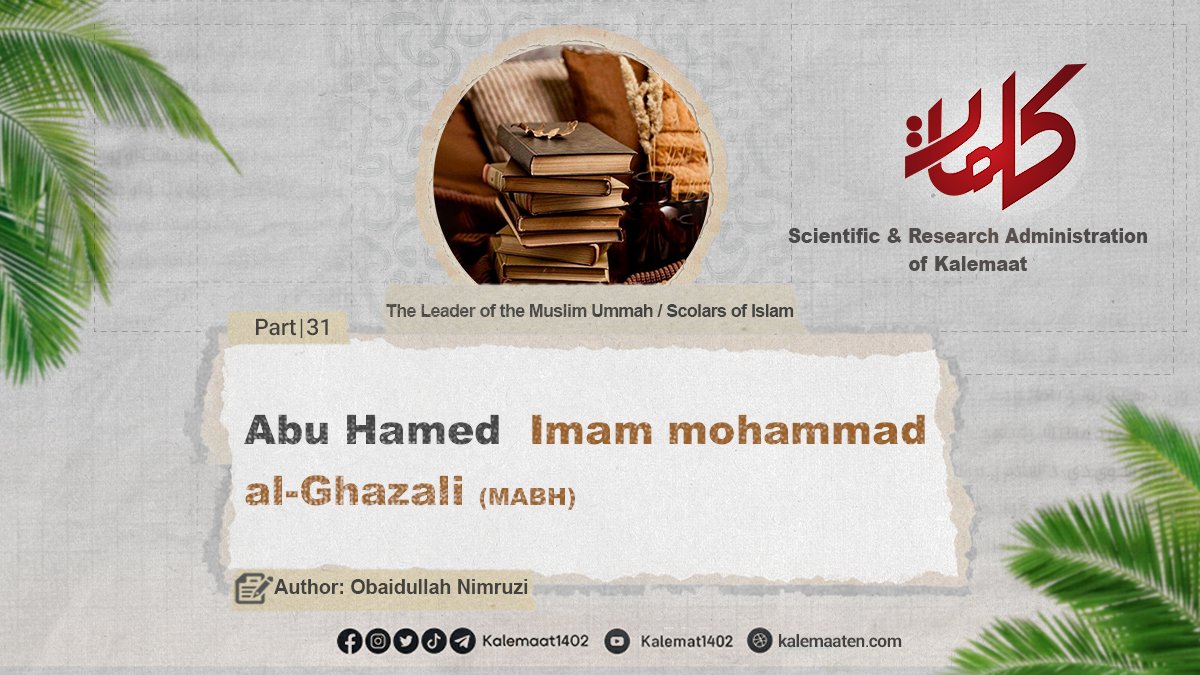
Author: Obaidullah Nimruzi
The Biography of Abu Hamed Imam Mohammad al-Ghazali [MABH] (Part 31)
Continuation of Imam Ghazali’s life and death
Imam Ghazali devoted most of his time to scientific and religious pursuits throughout his life; but he always had a spirit of seeking knowledge. In the past, he paid special attention to the rational sciences and some of the narrative sciences; but he had not been able to pay attention to the science of hadith as he should have. Therefore, in the last years of his life, Imam Ghazali decided to compensate for this deficiency, for this reason, he invited one of the most famous hadith scholars of that time, Hafiz Umar ibn Abul-Hasan al-Rawasi, to his house and studied the books Sahih Bukhari and Sahih Muslim from him and obtained the necessary documents.
Focusing on Hadith: Imam Ghazali’s Last Scientific Preoccupation
During this last period of Imam Ghazali’s life, most of his time was spent studying and engaging in the science of hadith. Ibn Asaker writes: “The last occupation of his life was to devote himself to the hadiths of the Prophet (peace and blessings of Allah be upon him) with full attention, and he chose to talk and sit with the scholars of hadith, and he began to study the Sahih Books (Bukhari and Muslim), which have the status of proof and chain of transmission in Islam.”
The book “Al-Mustasfi”: Imam Ghazali’s last work
A year before Imam Ghazali’s death, in the year 504 AH, he wrote the book “Al-Mustasfi”. This book is considered one of the three pillars of the principles of jurisprudence and received special attention from the scholars of jurisprudence. This work was his last work, which remained as a prominent monument throughout his scholarly life.
The death of Imam Ghazali: The moment his soul had flown
Imam Ghazali died on the 14th of Jamadi al-Akhar in the year 505 AH, at the age of 55 in Tabaran, and was buried in the same place. The Imam’s brother, Ahmad Ghazali, narrated the incident of his death as follows: “On Monday morning, he got up from bed, performed wudu and prayed; then he asked for his shroud and fasten it over his eyes and said: The order of my master on my eyes; then he lay down. People paid attention to him and saw that his soul had flown.” [1]
Two outstanding characteristics of Imam Ghazali (MABH): sincerity and high effort
Imam Ghazali (MABH) had two outstanding characteristics that are clearly visible in all aspects of his scientific and practical life: “sincerity” and “high effort”. Regarding his sincerity, not only his supporters; but also his opponents acknowledge this outstanding characteristic. This sincerity is seen in every word and writing that has survived from Imam Ghazali (MABH). Although Sheikh al-Islam Ibn Taymiyyah had ideological differences with Imam Ghazali (MABH) on various issues, considers him one of the greatest sincere people in the history of Islam. [2]
It was this sincerity that forced Imam Ghazali (MABH) to give up his greatest scientific positions and turn to the desert, and to resign from position in response to the requests of the kings and great men of the time to assume positions. Ibn Taymiyyah writes in this regard: “The last thing that comes out of the hearts of the truthful is the love of position,” and Imam Ghazali (MABH) showed in the last days of his life that he was deprived of this position. [3]
The second outstanding characteristic of Imam Ghazali (MABH) was his great effort. Imam Ghazali (MABH) never stopped striving to achieve scientific and practical perfection and was not satisfied or content with the high scientific positions of his time. Voices were always heard from him saying: “Traveler, this is not a place for you to stop.” Imam Ghazali (MABH) was ahead of his contemporaries in the narrative sciences, and his jurisprudential works and jurisprudential principles were studied and explained for centuries. Moreover, contrary to the usual practice of his time, and while other scholars only focused on the narrative sciences, Imam Ghazali (MABH) also paid special attention to the rational sciences and philosophy, and he delved deeply into the study of logic and philosophy. As Qazi Abu Bakr ibn Arabi stated: “Ghazali sank to the very heart and stomach of philosophy” and as a result, he wrote books that had a strong influence on philosophy for a century.
In the course of his spiritual development, Imam Ghazali (MABH) pledged allegiance to Sheikh Abu Ali Farmadi (MABH) in 477 AH and learned the sciences of Sufism from him; then, he sacrificed all his wealth and life for the sake of achieving spiritual and moral perfections for this path. Imam Ghazali (MABH) did not limit himself to writing and composing but also took steps in the field of social and political reforms and worked to establish the foundations of Islamic government. Maulana Shibili writes about this: Imam Ghazali (MABH) was not satisfied with the problems of corrupt monarchies and believed that when a government is established based on Islamic principles, the real goal cannot be achieved. [4]
The Uprising of Muhammad ibn Abdullah: The Continuator of Imam Ghazali’s Path
Imam Ghazali’s book Ihya’a Ulum al-Din reached Spain In the year 501 AH, and the King of Spain, Ali ibn Yusuf Tashfin, due to his bigotry and narrow-mindedness, ordered the book to be burned. When Imam Ghazali (MABH) was informed of his action, he was upset and saddened. At the same time, Muhammad ibn Abdullah Tarmut, a person from Spain and from an aristocratic family, came to the Imam’s service and after studying various sciences for a while, he decided to revolt against Ali ibn Yusuf in Spain and establish a new government based on Islamic principles. Muhammad ibn Abdullah decided to carry out this uprising after consulting with Imam Ghazali (MABH) and enlisting his support. Imam Ghazali, MABH, who always believed in fundamental reforms, supported this decision and asked whether the conditions were ready for this uprising.
Muhammad ibn Abdullah fought against the corruption of the courts and the oppressive rulers after traveling to various regions, including Egypt and Morocco. In Morocco, he bravely confronted the corruption of the court and even influenced King Ali ibn Yusuf. After a long struggle in Morocco, Muhammad ibn Abdullah went to Aghmat, where he gathered a large number of his followers and eventually, with the help of the Masamuda tribe, established an independent kingdom based on Islamic principles and succeeded in winning this uprising. [5]
These matters and events clearly show that Imam Ghazali, MABH, in addition to his scientific and spiritual perfections, also strived for social and political reforms and along this path, he trained his students, such as Muhammad ibn Abdullah, to realize Islamic ideals.
Continues…
Previous Part/ Next Part
[1]. Source: Tarikh-e Da’wat wa Islah (History of Invitation and Reform), vol. 1, p. 172.
[2]. Muhibb al-Din, Abi al-Fayd, Muhammad bin Muhammad bin Abd al-Razzaq al-Husseini al-Zubaidi al-Hanafi, Ithaf al-Sadat al-Muttaqin bi Sharh Ihya’ Ulum al-Din, page 11.
[3]. Previous source.
[4]. Tarikh-e Da’wat wa Islah (History of Invitation and Reform), vol. 1, page 173.
[5]. Previous source, pages 173-174.


